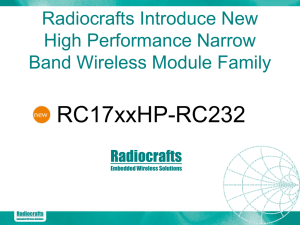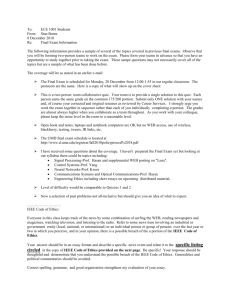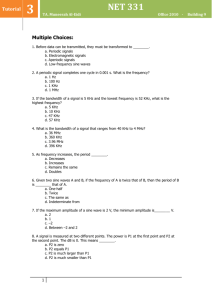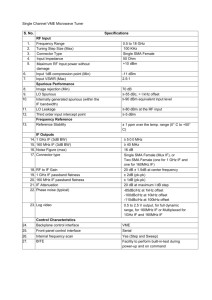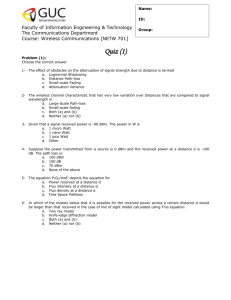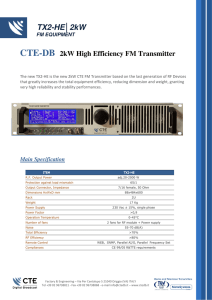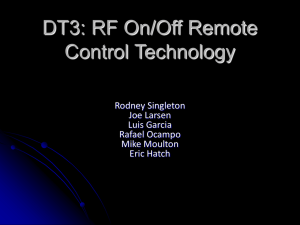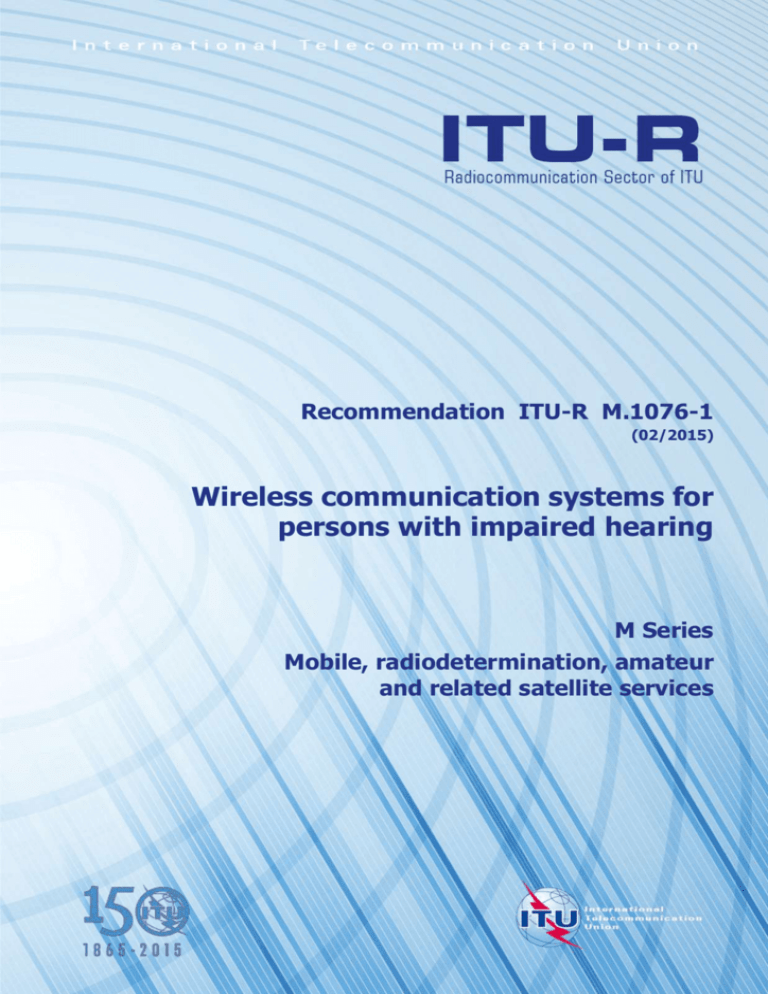
Recommendation ITU-R M.1076-1
(02/2015)
Wireless communication systems for
persons with impaired hearing
M Series
Mobile, radiodetermination, amateur
and related satellite services
ii
Rec. ITU-R M.1076-1
Foreword
The role of the Radiocommunication Sector is to ensure the rational, equitable, efficient and economical use of the radiofrequency spectrum by all radiocommunication services, including satellite services, and carry out studies without limit
of frequency range on the basis of which Recommendations are adopted.
The regulatory and policy functions of the Radiocommunication Sector are performed by World and Regional
Radiocommunication Conferences and Radiocommunication Assemblies supported by Study Groups.
Policy on Intellectual Property Right (IPR)
ITU-R policy on IPR is described in the Common Patent Policy for ITU-T/ITU-R/ISO/IEC referenced in Annex 1 of
Resolution ITU-R 1. Forms to be used for the submission of patent statements and licensing declarations by patent holders
are available from http://www.itu.int/ITU-R/go/patents/en where the Guidelines for Implementation of the Common
Patent Policy for ITU-T/ITU-R/ISO/IEC and the ITU-R patent information database can also be found.
Series of ITU-R Recommendations
(Also available online at http://www.itu.int/publ/R-REC/en)
Title
Series
BO
BR
BS
BT
F
M
P
RA
RS
S
SA
SF
SM
SNG
TF
V
Satellite delivery
Recording for production, archival and play-out; film for television
Broadcasting service (sound)
Broadcasting service (television)
Fixed service
Mobile, radiodetermination, amateur and related satellite services
Radiowave propagation
Radio astronomy
Remote sensing systems
Fixed-satellite service
Space applications and meteorology
Frequency sharing and coordination between fixed-satellite and fixed service systems
Spectrum management
Satellite news gathering
Time signals and frequency standards emissions
Vocabulary and related subjects
Note: This ITU-R Recommendation was approved in English under the procedure detailed in Resolution ITU-R
1.
Electronic Publication
Geneva, 2015
ITU 2015
All rights reserved. No part of this publication may be reproduced, by any means whatsoever, without written permission of ITU.
Rec. ITU-R M.1076-1
1
RECOMMENDATION ITU-R M.1076-1*
Wireless communication systems for persons with impaired hearing
(Question ITU-R 254/5)
(1994-2015)
Scope
This Recommendation provides the technical and operational characteristics for wireless accessibility of
hearing aids to public, home and personal audio services operating in the land mobile service.
Keywords
ALD, ALS, assistive listening device, hearing aid, wireless accessibility of hearing aids
Acronyms and abbreviations
ALD
Assistive listening device
ALS
Assistive listening systems
DSP
Digital signal processing
e.r.p.
Effective radiated power
LAN
Local area network
The ITU Radiocommunication Assembly,
considering
a)
that many forms of hearing impairment cannot be satisfactorily improved by audio
amplification only;
b)
that a number of means have been used to transfer speech signals to the listener’s hearing
device. These means include infrared radiation, use of the magnetic induction internal to current
loops, including operation at audio frequencies, VHF and UHF radio and the external induction field
of a radiating antenna;
c)
that some 10% of people suffer from mild to severe hearing loss;
d)
that users of aids for hearing impaired (hearing aids including assistive listening devices) are
found worldwide;
e)
that personal uses include access to mobile phone and personal audio applications;
f)
that home usage includes access to broadcast television, broadcast radio, emergency
notification and alarms;
g)
that public usage includes access to points of sales, counters, public address systems in areas
such as airports, train stations, religious places, theatres, events and cinemas;
h)
that the practical application of infrared systems and audio frequency induction loops to
communicate with persons with impaired hearing should also be considered for some applications,
*
The Director, Radiocommunication Bureau, is requested to bring this Recommendation to the attention of
the ITU-T Study Group JCA-AHF and the International Electrotechnical Commission (IEC).
2
Rec. ITU-R M.1076-1
recognizing
a)
that Resolution 175 (Rev. Busan, 2014) of the Plenipotentiary Conference resolves to take
account of persons with disabilities in the work of ITU,
noting
a)
that for public use it may be beneficial to have a standardized wireless system, operating on
globally harmonized tuning range;
b)
that there is a wide divergence in spectrum used around the world for assistive listening
devices;
c)
that administrations need to carefully consider suitable harmonized frequency ranges for the
operation of wireless systems for hearing impaired person,
recommends
that the technical and operational characteristics for radiocommunication systems for persons with
impaired hearing given in Annexes 1 and 2 should be used.
Annex 1
Operational characteristics of wireless communication systems
for persons with impaired hearing
1
System concepts
Historically, hearing aids consisted of little more than basic “miniature audio amplifiers” placed in or
behind the ear(s) solely boosting the incoming sounds. As semiconductor technology has evolved and
become miniaturised, hearing impaired people enjoy extremely sophisticated digital systems
incorporating a range of communication capabilities.
State-of-the-art technology uses specialized digital signal processing (DSP) technology that is
advanced enough to fulfil the stringent mechanical (ultra miniature) and power consumption
(only one small single cell battery) requirements that are specified for modern hearing aid devices.
DSPs manipulate the incoming sound spectrum mathematically, converting it into a digital
representation; programmable software then manipulates this digital representation to achieve:
–
background noise reduction;
–
correction of user specific deficiencies;
–
enhancement of sound cues and other listening parameters used by the brain to reconstruct
normal hearing.
Hearing aids contribute to user safety, comfort and enjoyable listening experience. However, real
life offers an incredible richness in different listening environments in some of which even the most
sophisticated hearing instruments show only a limited benefit. Examples of acoustic environments
or listening situations where the performance of conventional hearing instruments can substantially
be improved by applying additional communication devices are the following:
–
reverberant environments such as big churches or lecture halls;
–
communication over larger distances, e.g. in a lecture or in a classroom;
Rec. ITU-R M.1076-1
–
–
3
communication on the telephone, especially cell phones.
situations with large background noise levels (e.g. rooms, halls and areas with multi-talker
speech; engine noise inside or outside of trains and busses, etc.).
In these environments the application of assistive listening systems (ALS) based on wireless
communication technologies offer substantial additional benefits and significantly improve speech
intelligibility. The advent of digital broadcasting is now displacing some of the frequencies where
these wireless ALSs have traditionally operated.
In North America and Europe, approximately 1 person in 10 has some form of hearing loss, from
mild to severe. Today only 20% of these people are assisted by hearing aid technology. The binaural
rate (wearing two hearing aids: one left and one right) is ~75% to 80% in North America, ~60% in
Europe and 10% to 12% in the rest of the world. Reasons for such low adoption rates in general vary
from negative stigma associated with wearing cosmetically non-appealing devices to high cost and
certain types of hearing losses that could not be corrected.
Recent progress made in binaural hearing health revealed that having for example the right hearing
aid being able to communicate with the left hearing aid and vice versa helps achieve another level of
breakthrough in restoring someone’s hearing. This also directly contributes to the safety of that
person’s listening environment, for example directionality of sounds can be better perceived, in cases
such as an approaching ambulance or fire truck which cannot be seen but only heard, is physically
located. In some instances where one ear is totally impaired, sounds captured from that side of the
head can be relayed to the other ear and processed such as that person experiences full 360° hearing
again.
A major role of allowing the hearing impaired to communicate and also enjoy similar experiences to
those with normal hearing has been played by the Telecoil system which is in worldwide use.
Unfortunately these are difficult or impossible to install in large public places such as airports and
train stations and are both expensive to install and maintain. Also building owners are often reluctant
to allow them to be installed. In addition they only supply a single low quality voice channel. This
lack of flexibility and cost have given rise to an explosion of radio based systems for most teaching,
especially sports coaching1 and domestic use where multiple channels are required2.
Hearing aids can be described as body worn therapeutic medical devices used to provide improved
medical treatment of a patient. Therefore, they are subject to the very same constraints as all other
body worn medical devices:
–
They perform therapeutic tasks aimed at treating, curing, hence bettering patient’s lives.
–
They are installed/worn in and around the body.
–
They are subject to severe power consumption constraints, due to their discreet mechanical
size, that commands a very small source of energy (single cell battery).
–
A harmonized, worldwide deployable tuning range would facilitate the use of these devices
for international travellers in public areas.
–
These devices rely on the radio spectrum to be optimized in terms of energy spent for range
and link robustness achieved, hence a low noise floor and minimal interference band, where
body tissue absorption and spectrum usage density are taken into account.
1
Football and horse riding are some of the many sports now using this equipment for coaching.
2
Many schools require in excess of 25 channels.
4
Rec. ITU-R M.1076-1
–
If these devices are exposed to an environment of high emissions the user could experience
pain and possible damage3 to the ear drum and/or other physical incapacity.
2
Induction-Loop system (often referred to as Telecoil)
Inductive systems rely on coupling an audio amplifier, e.g. for the microphone of a speaker in
a lecture hall or a teacher in a classroom, directly to an induction loop system which basically directly
transmits the rather low frequency audio signal as a radiated time varying magnetic field. Induction
loop systems use a large coil antenna integrated in the floor of a large room for radiating the magnetic
field. Once properly installed, and given that the listener’s hearing aids include “T” coils, an IL system
is undoubtedly the most convenient and possibly the most cost effective ALS. To hear the audio, all
a person has to do is enter the looped area and switch his/her personal hearing aids to the telecoil
position. As long as the person’s hearing aids include “T” coils, he or she always has an assistive
device “receiver” available.
However this technology also has some technical drawbacks which limit the range of application of
this technology. The physics of inductive coupling requires the receiving coil (T-Coil) to be
perpendicularly oriented to the field of the sending coil or induction loop. This is sometimes difficult
to achieve because the orientation of the induction loop is fixed and the orientation of the T-Coil
depends on how it is built into the hearing instrument and the person's orientation. Furthermore, the
inductive transmission strongly depends on the distance between sender and receiver which sometime
results in a weak signal. The receiver also always has to remain within the loop in order to receive a
signal. External interferences (from power lines or fluorescent lights, computer monitors copiers, fax
machines, cell phones, etc.) creating background noises or distortions in the hearing instrument, are
difficult to remove. Next, in school environments, several different systems are required for different
classrooms. When applying two different systems in neighbouring classrooms it often is difficult to
avoid spill over from one induction loop system to the next although recently technological progress
has been made for reducing this problem. Furthermore, induction loop systems are not portable and
can only be applied where they have been pre-installed.
3
VHF and UHF systems
Current systems employing VHF and UHF FM (sub 2 000 MHz) radio transmission are capable of
providing communication over distances greater than those using the radio induction-field system, as
they employ transmission via a radiation field which decays less rapidly with distance than does an
induction field. As a consequence, VHF and UHF radio transmission systems require that each
transmission in any locale, such as a school classroom and its environs, be assigned a separate
frequency channel.
VHF and UHF reception is generally less susceptible to interference from natural and man-made
noise than is reception at lower frequencies and systems employing VHF and UHF radio transmission
will be useful in many circumstances to avoid local problems of interference which affect the
operation of the radio induction-field system.
Radiocommunication systems intended only for short-range communication are capable of producing
high field strengths at their required working distances, without radiating significant levels of power.
Exploitation of the resulting possibilities of shared spectrum usage can result in improved spectrum
utilization, and may allow large numbers of channels to be made available, for example to satisfy the
3
http://www.access-board.gov/research/interference.htm
http://www.fda.gov/Radiation-EmittingProducts/RadiationEmittingProductsandProcedures/
HomeBusinessandEntertainment/CellPhones/ucm116327.htm
Rec. ITU-R M.1076-1
5
requirements of large schools for any children with impaired hearing which is increasingly
a requirement of national legislation and an objective for children above five weeks old in many
countries.
Equipment takes a number of physical forms from add on receivers for behind the ear systems to belt
mounted units and necklace units. Currently narrow band FM systems predominate for teaching
systems with Bluetooth connectivity for mobile phones and some domestic equipment using radio
local area network (LAN) technology for connection to multimedia terminals.
Scarcity of spectrum has meant that the narrowband fixed frequency channel equipment using a 100%
duty cycle is not suitable for sharing with other services or short range devices (SRD); therefore
development of more spectrum efficient techniques such as frequency hopping and control from a
remote database are currently under development. One such system is shown below.
Overview of the system
Wireless audio systems considered here transmit speech or audio from a microphone, over a digital
radio link, to a receiver. An assistive listening system for use by the hearing impaired in public spaces
such as airports, railway stations, churches and theatres, where the transmitter is connected to the
audio programme or public address system and the receiver is worn by deaf users, or integrated into
users’ hearing aids.
The use of digital technology, e.g. with 4GFSK modulation and low bit-rate audio coding, provides
a balance between the need for good audio quality (a requirement to maintain intelligibility and
minimise user fatigue), spectrum efficiency and range. These systems can work well between
150 MHz and about 2 GHz.
Depending on available spectrum and coexistence requirements, systems to operate in approximately
200 kHz, 400 kHz and 600 kHz occupied bandwidth are outlined. The transmitter and receiver duty
cycle is inversely proportional to the bandwidth, which means that the amount of spectrum resource
used is roughly independent of the bandwidth, but the receiver power consumption is proportional to
the duty cycle.
This means that a 600 kHz system would allow receivers to consume approximately 1/3 the power of
a 200 kHz system, which is highly beneficial in power-limited applications such as hearing aids.
Wider bandwidth also decreases end-to-end delay, which is of benefit to many audio applications
where the audio must maintain lip-sync with the talker in order to maximise intelligibility.
Below are given technical parameters for wireless communication systems for access of hearing
impaired people to public services. The most appropriate channel bandwidth/parameters set should
be chosen in accordance with coexistence requirements for the radio frequency band in which such a
system would be realized.
6
Rec. ITU-R M.1076-1
200 kHz system
Channel bandwidth
200 kHz
Frequency tolerance
±0.005% (transmitter)
±0.005% (receiver)
Transmitter effective
radiated power
(e.r.p.)
10 mW
Transmitter field
strength @30m
88 dBV/m
Transmitter out
of band emission
@30m
70 dBV/m, 100 kHz from carrier, narrowband
40 dBV/m, 1 MHz from carrier, wideband
Transmitter
modulation
(indicative)
4GFSK @120 kbit/s, ±40 kHz maximum deviation (outer symbols), BT = 0.5
Transmitter duty
cycle (indicative)
30-50% for one audio channel
Receiver sensitivity,
direct inject
–80 dBm or better
Receiver selectivity
30 dB minimum, adjacent channel
40 dB minimum, alternate channel, image channel and above
Receiver blocking
rejection
50 dB minimum, ±2 MHz separation
Rec. ITU-R M.1076-1
Example transmitter
mask (max hold)
(note measurement
noise floor
at –55 dBm)
Nominal 200 kHz
bandwidth
Att 30 dB
Ref 10.00 dBm
RBW 3 0 kHz
VBW 1 0 kHz
SWT 15 ms M1
7
M1 (1)
8.35 dBm
867.952100000 MHz
1Pk 0 dBm
Max
– 10 dBm
– 20 dBm
– 30 dBm
– 40 dBm
– 50 dBm
– 60 dBm
– 70 dBm
– 80 dBm
CF 868.0 MHz
Date: 12.JUN.2012 11:12:50
Span 2.0 MHz
M.1076-01
Att 30 dB
Ref 10.00 dBm
RBW 3 0 kHz
VBW 1 0 kHz
SWT 6 0 ms
M1
M1 (1)
8.29 dBm
867.952100000 MHz
1Pk 0 dBm
Max
– 10 dBm
– 20 dBm
– 30 dBm
– 40 dBm
– 50 dBm
– 60 dBm
– 70 dBm
– 80 dBm
CF 868.0 MHz
Date: 12.JUN.2012 11:14:56
Span 10.0 MHz
M.1076-02
8
Example transmitter
mask (average and
max hold)
(note measurement
noise floor at
–55 dBm)
Nominal 200 kHz
bandwidth
Rec. ITU-R M.1076-1
Att 30 dB
Ref 10.00 dBm
RBW 3 0 kHz
VBW 1 0 kHz
SWT 15 ms
M1 (1)
–1.88 dBm
867.980000000 MHz
M1
1Pk 0 dBm
Clrw
2Pk
Max – 10 dBm
– 20 dBm
– 30 dBm
– 40 dBm
– 50 dBm
– 60 dBm
– 70 dBm
– 80 dBm
CF 868.0 MHz
Date: 12.JUN.2012 12:07:21
Att 30 dB
Ref 10.00 dBm
Span 2.0 MHz
M.1076-03
RBW 3 0 kHz
VBW 1 0 kHz
SWT 6 0 ms
M1 (1)
3.09 dBm
867.980000000 MHz
M1
1Pk 0 dBm
Clrw
2Pk – 10 dBm
Max
– 20 dBm
– 30 dBm
– 40 dBm
– 50 dBm
– 60 dBm
– 70 dBm
– 80 dBm
CF 868.0 MHz
Date: 12.JUN.2012 12:07:46
Span 10.0 MHz
M.1076-04
Rec. ITU-R M.1076-1
400 kHz system
Channel bandwidth
400 kHz
Frequency tolerance
±0.005% (transmitter)
±0.005% (receiver)
Transmitter e.r.p.
10 mW
Transmitter field
strength @30m
88 dBV/m
Transmitter out of
band emission @30m
70 dBV/m, 200 kHz from carrier, narrowband
40 dBV/m, 1 MHz from carrier, wideband
Transmitter
modulation
(indicative)
4GFSK @250 kbit/s, ±80 kHz maximum deviation (outer symbols), BT = 0.5
Transmitter duty
cycle (indicative)
15-25% for one audio channel
Receiver sensitivity,
direct inject
–80 dBm or better
Receiver selectivity
30 dB minimum, adjacent channel
40 dB minimum, alternate channel, image channel and above
Receiver blocking
rejection
50 dB minimum, ±2 MHz separation
9
10
Example transmitter
mask (average and
max hold)
(note measurement
noise floor at
–55 dBm)
Nominal 400 kHz
bandwidth
Rec. ITU-R M.1076-1
Att 30 dB
Ref 10.00 dBm
RBW 3 0 kHz
VBW 1 0 kHz
SWT 15 ms
1Pk 0 dBm
Clrw
2Pk
Max – 10 dBm
M1 (1)
–7.72 dBm
867.980000000 MHz
M1
– 20 dBm
– 30 dBm
– 40 dBm
– 50 dBm
– 60 dBm
– 70 dBm
– 80 dBm
CF 868.0 MHz
Date: 12.JUN.2012 12:00:49
Att 30 dB
Ref 10.00 dBm
Span 2.0 MHz
M.1076-05
RBW 3 0 kHz
VBW 1 0 kHz
SWT 60 ms
1Pk 0 dBm
Clrw
2Pk
– 10 dBm
Max
M1 (1)
–1.88 dBm
867.980000000 MHz
M1
– 20 dBm
– 30 dBm
– 40 dBm
– 50 dBm
– 60 dBm
– 70 dBm
– 80 dBm
CF 868.0 MHz
Date: 12.JUN.2012 12:01:04
Span 10.0 MHz
M .1076-06
Rec. ITU-R M.1076-1
600 kHz system
Channel bandwidth
600 kHz
Frequency tolerance
±0.005% (transmitter)
±0.005% (receiver)
Transmitter e.r.p.
10 mW
Transmitter field
strength @30m
88 dBV/m
Transmitter out of
band emission @30m
70 dBV/m, 300 kHz from carrier, narrowband
40 dBV/m, 1 MHz from carrier, wideband
Transmitter
modulation
(indicative)
4GFSK @500 kbit/s, ±120 kHz maximum deviation (outer symbols), BT = 0.5
Transmitter duty
cycle (indicative)
10-20% for one audio channel
Receiver sensitivity,
direct inject
–80 dBm or better
Receiver selectivity
30 dB minimum, adjacent channel
40 dB minimum, alternate channel, image channel and above
Receiver blocking
rejection
50 dB minimum, ±2 MHz separation
11
12
Example transmitter
mask (average and
max hold)
(note measurement
noise floor
at –55 dBm)
Nominal 600 kHz
bandwidth
Rec. ITU-R M.1076-1
Att 30 dB
Ref 10.00 dBm
RBW 3 0 kHz
VBW 1 0 kHz
SWT 15 ms
M1 (1)
0.73 dBm
867.980000000 MHz
M1
1Pk 0 dBm
Clrw
2Pk – 10 dBm
Max
– 20 dBm
– 30 dBm
– 40 dBm
– 50 dBm
– 60 dBm
– 70 dBm
– 80 dBm
CF 868.0 MHz
Date: 12.JUN.2012 12:34:39
Att 30 dB
Ref 10.00 dBm
Span 2.0 MHz
M .1076-07
RBW 3 0 kHz
VBW 1 0 kHz
SWT 60 ms
1Pk 0 dBm
Clrw
2Pk
Max – 10 dBm
M1 (1)
–4.19 dBm
867.980000000 MHz
M1
– 20 dBm
– 30 dBm
– 40 dBm
– 50 dBm
– 60 dBm
– 70 dBm
– 80 dBm
CF 868.0 MHz
Date: 12.JUN.2012 12:34:22
Span 10.0 MHz
M .1076-08
Rec. ITU-R M.1076-1
Annex 2
Technical characteristics of wireless communication systems
for persons with impaired hearing
1
LF and MF radio systems
1.1
30~190 kHz (China)
Magnetic field strength limits @10 m:
for 30~50 kHz:
for 50~190 kHz:
1.2
72 dBμA/m (quasi-peak value)
72 dBμA/m (–3 dB/octave) (quasi-peak value).
315 kHz~1 MHz (China)
≤ mn dBmn/m (quasi-peak value)
Magnetic field strength limits @10 m:
1.3
1.7~2.1 MHz, 2.2~3.0 MHz (China)
Magnetic field strength limits @10 m:
Frequency tolerance:
Chanel bandwidth (6 dB):
1.4
≤9 dBμA/m (quasi-peak value)
0.0001
≤ 200 kHz
1~3 MHz except the frequencies listed in § 1.3 (China)
Magnetic field strength limits @10 m:
≤ –15 dBμA/m (quasi-peak value)
2
HF radio systems
2.1
3-11 MHz (not implemented in all regions)
2.2
Channel bandwidth
300-400 kHz
Frequency tolerance
< ±1%
Transmitter field strength @10 m
< –20 dBA/m
Transmitter modulation (indicative)
FSK @300 kbit/s
Transmitter duty cycle (indicative)
30-50% for one audio channel
3.1~4.1 MHz, 4.2~5.6 MHz, 5.7~6.2 MHz, 7.3~8.3 MHz, 8.4~9.9 MHz (China)
Magnetic field strength limits @10 m:
Frequency tolerance:
Chanel bandwidth (6 dB):
2.3
≤ 9 dBμA/m (quasi-peak value)
0.0001
≤ 200 kHz.
6.765~6.795 MHz, 13.553~13.567 MHz, 26.957~27.283 MHz (China)
Magnetic field strength limits @10 m:
Frequency tolerance:
Spurious emissions (transmitter):
≤ 42 dBμA/m (quasi-peak value)
0.0001
13
14
Rec. ITU-R M.1076-1
For equipment operated in frequency band 13.553-13.567 MHz, the magnetic field strength limit for
offset within 140 kHz at both ends of this frequency band is 9 dBμA/m(@10 m, quasi-peak value).
2.4
3~30 MHz except the frequencies listed in §§ 2.2 and 2.3 (China)
Magnetic field strength limits @10 m:
3
≤ –15dBμA/m (quasi-peak value).
VHF and UHF radio systems
In some parts of the world, systems have successfully shared various frequency bands in the range
169-220 MHz for many years, with the type of radio services to which these frequency bands are
allocated by the Radio Regulations. With the introduction of assistive listening device (ALD) systems
for public spaces which can be controlled from a database better sharing with broadcast services could
be expected.
3.1
40.66-40.70 MHz (China)
FM fixed channel system with 100% duty cycle
Transmitter e.r.p.:
10 mW
Frequency tolerance:
Spurious emissions (transmitter):
0.0001
27 dBA/m@10 m (9-150 kHz, measurement bandwidth: 200 Hz)
27 dBA/m@10 m (150 kHz-10 MHz, measurement bandwidth: 9 kHz)
–3.5 dBA/m@10 m (10-30 MHz, measurement bandwidth: 9 kHz)
250 nW (30-1 000 MHz, measurement bandwidth: 100 kHz)
4 nW (48.5~72.5, 76-108, 167-223, 470-566, 606-798 MHz, measurement bandwidth:
100 kHz).
3.2
72-76 MHz (not implemented in all regions)
Antenna length and man-made noise are an issue.
Channel bandwidth:
50 kHz for a narrow-band device
200 kHz for a wideband device
Frequency tolerance:
0.005% (transmitter)
Frequency stability:
0.005% (receiver)
Field strength produced at 30 m:
Not to exceed 8 000 µV/m
Transmitter e.r.p.:
1 170 µW (calculated from above)
Modulation requirements for FM:
20 kHz maximum (narrow-band)
75 kHz maximum (wideband)
Out-of-band emissions:
Receiver selectivity:
Receiver image rejection:
25 kHz or more from carrier, no more than
150 µV/m at 30 m for narrow-band
150 kHz or more from carrier, no more than
150 µV/m at 30 m for wideband
40 dB minimum, adjacent channel
40 dB minimum.
Rec. ITU-R M.1076-1
3.3
75.4-76 MHz (China)
FM fixed channel system with 100% duty cycle
Channel bandwidth:
< 200 KHz
Transmitter e.r.p.:
10 mW
Frequency tolerance:
0.0001
Spurious emissions (transmitter):
27 dBA/m@10 m (9-150 kHz, measurement bandwidth: 200 Hz)
27 dBA/m@10 m (150 kHz-10 MHz, measurement bandwidth: 9 kHz)
–3.5 dBA/m@10 m (10-30 MHz, measurement bandwidth: 9 kHz)
250 nW (30-1 000 MHz, measurement bandwidth: 100 kHz)
4 nW (48.5~72.5, 76-108, 167-223, 470-566, 606-798 MHz, measurement bandwidth:
100 kHz).
3.4
84-87 MHz (China)
FM fixed channel system with 100% duty cycle
Channel bandwidth:
< 200 KHz
Transmitter e.r.p.:
10 mW
Frequency tolerance:
0.0001
Spurious emissions (transmitter):
27 dBA/m@10 m (9-150 kHz, measurement bandwidth: 200 Hz)
27 dBA/m@10 m (150 kHz-10 MHz, measurement bandwidth: 9 kHz)
–3.5 dBA/m@10 m (10-30 MHz, measurement bandwidth: 9 kHz)
250 nW (30-1 000 MHz, measurement bandwidth: 100 kHz)
4 nW (48.5~72.5, 76-108, 167-223, 470-566, 606-798 MHz, measurement bandwidth:
100 kHz).
3.5
87-108 MHz (China)
FM fixed channel system with 100% duty cycle
Channel bandwidth:
< 200 KHz
Transmitter e.r.p.:
3 mW
Frequency tolerance:
0.0001
Spurious emissions (transmitter):
27 dBA/m@10 m (9-150 kHz, measurement bandwidth: 200 Hz)
27 dBA/m@10 m (150 kHz-10 MHz, measurement bandwidth: 9 kHz)
–3.5 dBA/m@10 m (10-30 MHz, measurement bandwidth: 9 kHz)
250 nW (30-1 000 MHz, measurement bandwidth: 100 kHz)
1 000 nW (1 000 MHz-10th harmonics, measurement bandwidth: 1 MHz)
4 nW (48.5~72.5, 167-223, 470-566, 606-798 MHz, measurement bandwidth: 100 kHz).
15
16
3.6
Rec. ITU-R M.1076-1
169 MHz band (Europe and Japan)
Analogue FM fixed channel system with 100% duty cycle
Channel bandwidth:
< 50 kHz
Transmitter e.r.p.:
10 mW or <500 mW public systems (Europe only),
individual licence required
Spurious emissions (transmitter):
4 nW (41-68, 87.5-118, 162-230, 470-872 MHz)
(250 nW elsewhere below 1 000 MHz)
20 nW (above 1 000 MHz)
Spurious emissions (receiver):
2 nW (100 kHz-1 000 MHz)
20 nW (1 000-4 000 MHz).
3.7
173-175 MHz (in some European countries)
Analogue FM fixed channel system with 100% duty cycle
Channel bandwidth:
< 50 kHz
Frequency tolerance:
5 kHz
Transmitter e.r.p.:
2-10 mW
Spurious emissions (transmitter):
4 nW (41-68, 87.5-118, 162-230, 470-872 MHz)
(250 nW elsewhere below 1 000 MHz)
20 nW (above 1 000 MHz)
Spurious emissions (receiver):
2 nW (100 kHz-1 000 MHz)
20 nW (1 000-4 000 MHz).
3.8
173.3-174.0 MHz (Korea)
Analogue FM fixed channel system with 100% duty cycle
Channel bandwidth:
< 200 kHz
Frequency tolerance:
0.002%
Transmitter e.r.p.:
< 10 mW
Spurious emissions (transmitter):
250 nW (–36 dBm) (below 1 000 MHz with
reference bandwidth of 100 kHz)
1 W (–30 dBm) (above 1 000 MHz with reference
bandwidth of 1 MHz)
Spurious emissions (receiver):
4 nW (–54 dBm) (above 9 kHz).
3.9
174-216 MHz (in some European countries)
Analogue FM fixed channel system with 100% duty cycle
Channel bandwidth:
< 50 kHz
Frequency tolerance:
5 kHz
Transmitter e.r.p.:
10-50 mW
Spurious emissions (transmitter):
4 nW (41-68, 87.5-118, 162-230, 470-872 MHz)
(250 nW elsewhere below 1 000 MHz)
20 nW (above 1 000 MHz)
Rec. ITU-R M.1076-1
Spurious emissions (receiver):
3.10
17
2 nW (100 kHz-1 000 MHz)
20 nW (1 000-4 000 MHz).
216-217 MHz (USA)
Analogue FM fixed channel system with 100% duty cycle
Channel bandwidth:
< 50 kHz
Frequency tolerance:
5 kHz
Transmitter e.r.p.:
100 mW
Spurious emissions (transmitter):
4 nW (41-68, 87.5-118, 162-230, 470-872 MHz)
(250 nW elsewhere below 1 000 MHz)
20 nW (above 1 000 MHz)
Spurious emissions (receiver):
2 nW (100 kHz-1 000 MHz)
20 nW (1 000-4 000 MHz).
3.11
216-217 MHz (Korea)
Analogue FM fixed channel system with 100% duty cycle
Channel bandwidth:
< 200 kHz
Frequency tolerance:
0.002%
Transmitter e.r.p.:
< 10 mW
Spurious emissions (transmitter):
250 nW (–36 dBm) (below 1 000 MHz with
reference bandwidth of 100 kHz)
1 W (–30 dBm) (above 1 000 MHz with reference
bandwidth of 1 MHz)
Spurious emissions (receiver):
4 nW (–54 dBm) (above 9 kHz).
3.12
189.9~223.0 MHz (China)
FM fixed channel system with 100% duty cycle
Channel bandwidth:
< 200 kHz
Transmitter e.r.p.:
10 mW
Frequency tolerance:
0.0001
Spurious emissions (transmitter):
4 nW (48.5~72.5, 76-108, 470-566, 606-798 MHz, measurement bandwidth: 100 kHz)
250 nW (30-1 000 MHz, measurement bandwidth: 100 kHz)
1 000 nW (1 000 MHz-10th harmonics, measurement bandwidth: 1 MHz)
3.13
470~510 MHz (China)
FM fixed channel system with 100% duty cycle
Channel bandwidth:
< 200 KHz
Transmitter e.r.p.:
50 mW
Frequency tolerance:
0.0001
Spurious emissions (transmitter):
18
Rec. ITU-R M.1076-1
4 nW (48.5~72.5, 76-108, 167~223, 510~566, 606-798 MHz, measurement bandwidth:
100 kHz)
250 nW (30-1 000 MHz, measurement bandwidth: 100 kHz)
1 000 nW (1 000 MHz-10th harmonics, measurement bandwidth: 1 MHz)
3.14
630~787 MHz (China)
FM fixed channel system with 100% duty cycle
Channel bandwidth:
< 200 KHz
Transmitter e.r.p.:
50 mW
Frequency tolerance:
0.0001
Spurious emissions (transmitter):
4 nW (48.5~72.5, 76-108, 167~223, 470~566 MHz, measurement bandwidth: 100 kHz)
250 nW (30-1 000 MHz, measurement bandwidth: 100 kHz)
1 000 nW (1 000 MHz-12.5 GHz, measurement bandwidth: 1 MHz)
3.15
863-865 MHz (Europe)
Specification ETSI EN 301 357
FM fixed channel system with 100% duty cycle
3.16
Channel bandwidth:
< 200 KHz
Transmitter radiated power:
10 mW
Spurious emissions (transmitter):
4 nW (41-68, 87.5-118, 162-230, 470-872 MHz)
(250 nW elsewhere below 1 000 MHz)
20 nW (above 1 000 MHz)
Spurious emissions (receiver):
2 nW (100 kHz-1 000 MHz)
20 nW (1 000-4 000 MHz)
2 400~2 483.5 MHz (China)
FM fixed channel system with 100% duty cycle
Channel bandwidth:
< 200 KHz
Transmitter e.r.p.:
10 mW
Frequency tolerance:
75 kHz
Spurious emissions (transmitter):
4 nW (48.5~72.5, 76-108, 167~223, 470~566, 606-798 MHz, measurement bandwidth:
100 kHz)
250 nW (30-1 000 MHz, measurement bandwidth: 100 kHz)
1 000 nW (1 000 MHz-12.5 GHz, measurement bandwidth: 1 MHz)
______________


